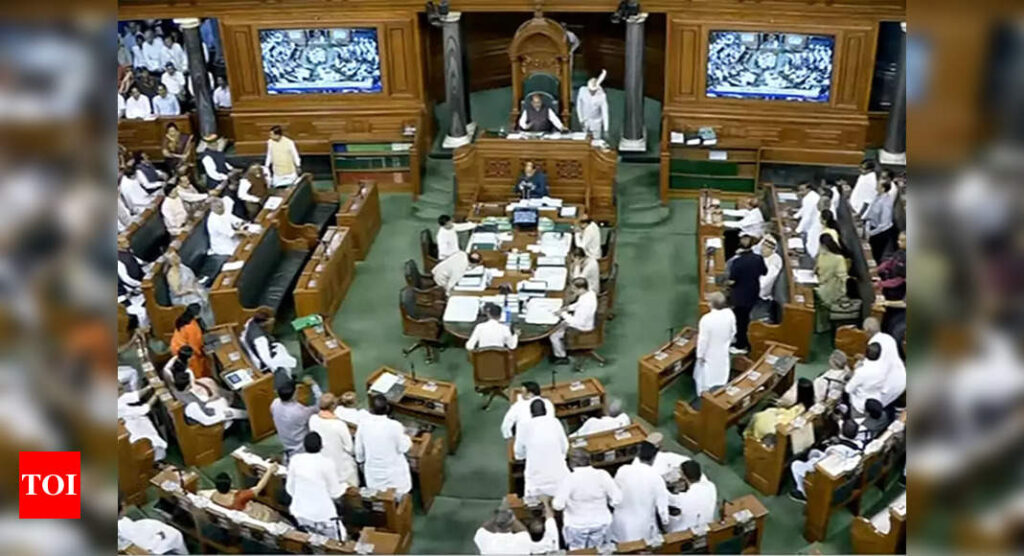[ad_1]
The debate on the motion will take place from August 8 to 10 and Prime Minister Narendra Modi is likely to reply to the opposition-sponsored move on the last day.
The numbers are clearly in favour of the ruling NDA and the motion is expected to be defeated. However, the opposition wants to win the “battle of perception” by cornering the government, particularly PM Modi, on the Manipur issue during the debate.
Here’s all you need to know about the no-trust motion …
Opposition’s INDIA vs Modi government
Regardless of the fate of the no-confidence motion, Parliament is expected to witness a politically charged debate over the next three days which will further give shape to the clash between opposition’s newly formed bloc INDIA and a reconstituted NDA led by BJP.
The Business Advisory Committee of the Lok Sabha has allotted 12 hours for the discussion on the no-trust motion.
Congress leader Rahul Gandhi, whose Lok Sabha membership was reinstated on Monday, is expected to lead the opposition’s charge in the lower house. The Wayanad MP will be delivering a “crucial speech” during the no-confidence motion debate on Tuesday, Congress MP Manickam Tagore said earlier today.
Several other prominent MPs, some of whom also visited strife-torn Manipur recently, are expected to corner the Modi government during the debate.
Meanwhile, on August 10, PM Modi is expected to respond to the opposition’s charges and hit back at the newly formed bloc on the last day of the debate.
While PM Modi did express anguish over the incident of two tribal women being paraded naked and gang-raped in Manipur before the monsoon session begin, he is yet to speak about the issue in detail in Parliament.
The numbers
The fate of the no-confidence motion, moved by Congress MP Gaurav Gogoi on behalf of the united opposition, is clear as the NDA has the support of a majority members in Lok Sabha.
With 301 MP of its own, the NDA has a total of 325 MPs in Lok Sabha.
On other hand, the opposition alliance, including Congress, has about 141 members.
Neutral parties like KCR’s BRS, YS Jagan Reddy’s YSRCP and Naveen Patnaik’s BJD have combined strength of 41. The remaining few seats are divided between other unallied parties as well as Independents.
This means that if it comes to the vote, the motion will be easily defeated by the ruling BJP. However, the opposition bloc views the debate as a “battle of perception” as it plans to go all-out against the Modi government over the ethnic violence in Manipur.
What is a no-confidence motion?
A no-confidence motion is a formal process in which a legislature expresses its lack of confidence in the government. In India, the no-confidence motion can be moved only in the Lok Sabha, the lower house of Parliament.
To move a no-confidence motion, a member of the Lok Sabha must give a written notice of the motion which must be signed by at least 50 members of the House.
Once the notice is received, the Speaker of the Lok Sabha will decide whether to admit the motion for discussion. If the motion is admitted, it will be debated in the House and a vote will be taken. If the government loses the vote, it will be forced to resign.
Previous no-confidence motions
Since independence, as many as 27 no-confidence motions have been moved in the Lok Sabha.
The first no-confidence motion was moved against Prime Minister Jawaharlal Nehru in 1963. PM Indira Gandhi faced the most no-confidence motions (15), followed by Lal Bahadur Shastri and PV Narasimha Rao (three each). The Atal Bihari Vajpayee government lost the no-confidence motion by a margin of one vote (269–270) in April 1999.
The most recent no-confidence motion was moved against the Narendra Modi government in 2018. The motion was defeated by a vote of 325 to 126.
(With inputs from agencies)
[ad_2]
Source link











More Stories
Congress replaces Kamal Nath, names an OBC as Madhya Pradesh chief | India News
Fire breaks out in ITBP camp in Srinagar; none hurt | India News
Parliament Security: Co-villagers give clean chit to Lalit Jha, parents to move court | India News